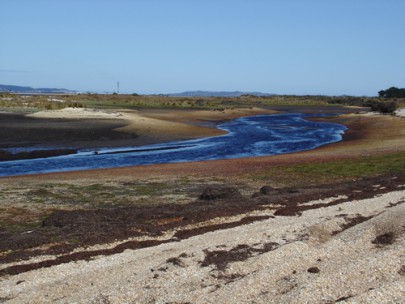Estuaries
In this section

Awarua Estuary, Southland (Rowan Buxton)
Estuaries are where fresh water from rivers mixes with salt water. They are formed where the underlying or adjacent topography constrains the mixed water throughout the tidal cycle. They are formed behind barriers such as sand spits and coastal embayments, at river mouths, in drowned river valleys with gently sloping substrates, and even in fjords. Their inland limit is where salinity reaches a dilution of 5% of the marine concentration (Clarkson et al. 2003). Sheltered, northern estuaries can support mangroves (Avicennia marina).
Notable flora and fauna
Threatened and rare plants include the nationally critical grey bush (Atriplex cinerea), coastal peppercress (Lepidium banksii), and saltgrass (Puccinellia raroflorens); the nationally vulnerable Machaerina complanata; the declining Leptinella tenella, sea sedge (Carex litorosa), tufted hair-grass (Deschampsia cespitosa); and the naturally uncommon Kirk’s crassula (Crassula kirkii), creeping fuchsia (Fuchsia procumbens), Leptinella dispersa subsp. dispersa, Leptinella plumosa, native musk (Mimulus repens), Chatham Islands salt grass (Puccinellia chathamica), and Puccinellia walkeri subsp. walkeri. Relicts include the orache (Atriplex australasica), colonisers include the narrow-leaved Wilsonia (Wilsonia backhousei), and the data deficient wind grass (Lachnagrostis tenuis).
Estuaries support many bird species, but while only a few are threatened , estuaries as a whole are vital for bird conservation. Some birds nest on the estuary margins, such as the ‘sparse’ banded rail (Rallus phillepensis). Others nest mainly, or exclusively, outside of estuaries elsewhere in New Zealand, such as on riverbeds, and visit estuaries only during the winter, e.g. ‘nationally vulnerable’ wrybill (Anarhynchus frontalis) and the ‘critical’ white heron (Egretta alba subsp. modesta).
Most of the migratory winter visitors are from the Northern Hemisphere and although New Zealand estuaries are critical to their survival, such as the bartailed godwit (Limosa lapponica), none are ranked as endangered.
Estuaries are important breeding grounds for some native fish, particularly Galaxias spp. (juveniles are whitebait) including the threatened short-jawed kokopu (Galaxias postvectis).
Threat status
Vulnerable (Holdaway et al. 2012)
Threats
Aggressive invasive weeds have changed the character of estuaries, e.g. Spartina spp., saltwater paspalum (Paspalum vaginatum), Juncus acutus,J. geradii and Carex divisa. Invasive fauna also forms a threat, e.g. the introduced portunid crab (Charybdis japonica). Estuarine margins in agricultural settings are grazed, trampled, and there are potential problems of nutrient enrichment from fertiliser and stock. Estuarine systems under greatest threat from urban development are near centres of population. Introduced animals pose a high threat in unfenced estuarine margins accessible by domestic and feral animals. These systems are fragile and prone to trampling/browsing damage. There is little threat from on-site erosion, but upper-catchment erosion and sedimentation exacerbate mangrove spread and hence change of ecosystem structure and function. Drainage is mainly a threat on margins that are less influenced by tidal regimes. Aquaculture is an increasing threat in some localities.
Where do they occur?
Estuaries are widespread in New Zealand (more so than lagoons) and occur in about 40 ecological regions from Northland to Fiordland.
Further reading
Clarkson BR, Sorrell BK, Reeves PN, Champion PD, Partridge TR, Clarkson BD 2003. Handbook for monitoring wetland condition. Coordinated monitoring of New Zealand wetlands. Ministry for the Environment SMF funded project. Wellington, MfE.
Dowding JE, Moore SJ 2006. Habitat networks of indigenous shorebirds in New Zealand. Science for Conservation 261. Wellington, Department of Conservation.
Fowler AE, Gerner NV, Sewell MA 2011. Temperature and salinity tolerances of Stage 1 zoeae predict possible range expansion of an introduced portunid crab, Charybdis japonica, in New Zealand. Biological Invasions 13: 691-699.
Fry B, Rogers K, Barry B, Barr N, Dudley B 2011. Eutrophication indicators in the Hutt River Estuary, New Zealand. New Zealand Journal of Marine and Freshwater Research 45: 665-677.
Johnson P, Gerbeaux P 2004. Wetland types in New Zealand. Wellington, Department of Conservation.
Winterbourn M, Knox G, Burrows C, Marsden I eds 2008. The natural history of Canterbury. Christchurch, Canterbury University Press. 921 p.


